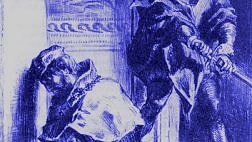 CHECK OUT YOUR FREE
CHECK OUT YOUR FREE
SAMPLE ESSAY BELOW

Check out your free
sample essay below

Essay introduction /
Thesis statement
“One may smile … and be a villain”
The characters of Prince Hamlet and King Claudius in Shakespeare’s Hamlet provide examples of both external and internal conflict. They are two individuals at war with each other—and themselves.
Hamlet enjoys play-acting in theater. The prince’s happiest moment in the play is the arrival of the Players. As Rosencrantz reports: “there did seem in him a kind of joy” (3.1).
Claudius practices play-acting in politics. “He that plays the king” (2.2) delights in stage-managing “a little shuffling” with Laertes: a sharpened, tainted sword and—in the event of a “bad performance”—a poisoned wine goblet (4.7).
The relationship between uncle and nephew begins with mutual suspicion, escalates into a psychological battle, and concludes with defeat for both. In the end, it is not Denmark’s Old King Hamlet but Old King Fortinbras of Norway who wins revenge.
SHARE THE SHAKESPEARE
Prince #Hamlet and King Claudius: two men at war with each other - and themselves.
1
Hamlet and Claudius:
player prince, imposter king
“Who’s there? … stand and unfold yourself”
“Who’s there?”—The guard Barnardo’s opening question is asked by Prince Hamlet and King Claudius of each other over the play’s first three acts. Nephew and uncle each suspects—correctly—that the other is hiding a secret.
Claudius impersonates a rightful monarch; as he admits in an aside, his false kingship is like a “beautied … harlot’s cheek” (3.1). Hamlet impersonates himself; for his put-on “antic disposition” (1.5) expresses his very real inner turmoil: “it hath made me mad” (3.1).
The troubled conscience of the false king over “a brother’s murder” (3.3) mirrors the inner struggle of the tormented prince with the morality of revenge.
With Polonius, Claudius directs Rosencrantz, Guildenstern and Ophelia as amateur actors in “‘twere by accident” (3.1) performances to uncover the true state of mind of Gertrude’s “too much changed son” (2.2).
The arrival of the Players enables Hamlet to use professional actors in his own theatrical ploy of a ‘play-within-a-play’ “to catch the conscience of the king” (2.2).
SHARE THE SHAKESPEARE
A usurping Claudius impersonates a rightful king. An anguished, antic #Hamlet impersonates himself.
2
Hamlet and Claudius at The Murder of Gonzago
“The play’s the thing”
At The Murder Gonzago in 3.2, the king sits unperturbed through two reenactments of Old King Hamlet’s poisoning: the first in the dumbshow, the second in the spoken play. As shown later in 4.5 with Laertes’ mob-leading castle invasion, Claudius is too composed a figure to betray emotion in public.
It is only when Hamlet identifies the stage-murderer Lucianus as “nephew to the king” that Claudius reacts. Such a public threat to the king’s life provides him with a plausible excuse for exiting the hall, his crime in the palace orchard still unrevealed to the court.
It is rather Hamlet’s “occulted guilt” that is exposed by The Murder of Gonzago. Minutes later and still inflamed by the “knavish piece of work … writ in choice Italian”, Hamlet rashly stabs Polonius (“Dead for a ducat”, 3.4).
Claudius then exiles Hamlet to England, supposedly “for thine especial safety” (4.3), but in reality to his execution.
SHARE THE SHAKESPEARE
#Hamlet's antic performance at his play leaves him caught in his own 'Mousetrap'.
3
Hamlet and Claudius: the two delayers
“I stand in pause”
Prince Hamlet’s play-within-a-play does cause Claudius to “proclaim” his “malefactions” (2.2)—but in his private chapel in 3.3 rather than publicly in front of the court. Torn between repenting or not, the king feels “like a man to double business bound.”
The man who he is like is, of course, Hamlet. For the prince now declares he wishes both to murder the body and damn to hell the soul of his despised uncle. For this reason, Hamlet decides to wait until he catches the kneeling-in-prayer Claudius in “some act / That has no relish of salvation in’t.”
In the at-prayer Claudius, does Hamlet see an image of his future self were he to murder his uncle in such cowardly circumstances?
Afterwards, should he succeed Denmark’s king, might Hamlet too find himself also struggling with a “limed soul” in the same royal chapel? And, like Claudius, could Hamlet find forgiveness only by giving up “those effects for which (he) did the murder”?
SHARE THE SHAKESPEARE
#Hamlet seeks to reunite in the afterlife his fractured-by-Claudius family of mother and father.
4
Hamlet, Claudius and Gertrude
“Cleft my heart in twain”
At two different points the play, Queen Gertrude and Prince Hamlet each use the same word to describe each other: ‘wretch’, a term of pity rather than respect.
She fails to understand why Hamlet will not “look like a friend on Denmark” (1.2) but instead loiters sadly about Elsinore like a “poor wretch” (2.2). Hamlet’s final words to his mother as she expires from the same poison that killed his father are: “Wretched Queen, adieu!” (5.2).
That the Ghost who appears in Gertrude’s closet is visible only to the prince reveals how Hamlet is still haunted by his father’s memory (“Do you see nothing there?”), but Gertrude lives only in the present (“No, nothing but ourselves”, 3.3).
Contrary to the Ghost’s command of “leave her to heaven” (1.4), Hamlet tries to separate his mother from Claudius— “Repent what’s past. Avoid what is to come” (3.4).
However, Hamlet’s parting words to a dying King Claudius (“Follow my mother”, 5.2) tells us he believes it will be in the company of her villainous second husband rather than his own “dead father murdered” (2.2) that his “good mother” (3.3) will be eternally united.
SHARE THE SHAKESPEARE
#Hamlet - King Claudius' sentimental descriptions of Gertrude reveal another side of his character.
5
Essay conclusion / Summary
“As kill a king”
In 5.1, Hamlet’s exchange with Laertes in Ophelia’s grave reveals how the prince has left behind the vengeful anger that now holds Polonius’ son in its grip. When Laertes exclaims “The devil take thy soul!”, Hamlet, who earlier asked “shall I couple hell?” (1.5) replies: “Thou prayest not well.”
The “providence” (5.2) to which Hamlet has surrendered his fate he now believes will provide the circumstances for him to complete the task for which “my fate cries out” (1.4). All the prince need do is be prepared to act his assigned part when the right moment comes, for, as he tells Horatio, “the readiness is all” (5.2).
In contrast, Claudius remains a scheming villain to the very end. In one final example of the “witchcraft of his wit” (1.5), Claudius sets the Laertes and Hamlet against each other in a “forgery of shapes and tricks” (4.7): a murder plot disguised as a fencing duel of honor.
In the end, Claudius is “justly served” by “a poison tempered by himself.” And, if at the cost of his life, but without the taint of private revenge, Hamlet removes from Denmark’s throne the usurper who twice plotted his murder and whose villainy led to the deaths of both his parents.
SHARE THE SHAKESPEARE
#Hamlet damns Claudius to hell in eternal marriage with his mother there.
6
The most helpful book ever for students and teachers of Shakespeare’s Hamlet.
42 x 1,500-word model essays

Chapter-by-chapter guide to Hamlet Model Essays
IN THIS BOOK ARE THREE 1,500-WORD SAMPLE ESSAYS ON EACH ONE OF THE FOLLOWING 14 CHARACTERS, RELATIONSHIPS, AND THEMES. THAT’S 42 SAMPLE ESSAYS IN TOTAL.

#1: The Character of Hamlet
Born a prince, parented by a jester, haunted by a ghost, destined to be killed for killing a king, and remembered as the title character of a play he did not want to be in. If at the cost of his life, Hamlet does in the end “win at the odds.”

#2: The Character of Claudius
His “ambition” for Denmark’s crown leads him to commit one murder only to find that he must plot a second to cover up the first. When this plan fails, his next scheme leads to the death of the woman he loves followed by his own.

#3: The Character of Gertrude
“Have you eyes?”, Prince Hamlet demands of his mother. Gertrude‘s “o’erhasty marriage” dooms her life and the lives of everyone around her when her wished-for, happy-ever-after fairytale ends in a bloodbath.

#4: The Character of Ophelia
As she struggles to respond to the self-serving purposes of others, Ophelia’s sanity collapses in Elsinore’s “unweeded garden” of falsity and betrayal. Her “self-slaughter” is her revenge for her silencing and humiliation.

#5: Relationship of Hamlet and the Ghost
Hamlet grants the Ghost the atonement his suffering soul needed more than the revenge he demanded: he surrenders Denmark to the son of the man murdered by his father on the day of the prince’s birth.

#6: Relationship of Hamlet and Claudius
Uncle and nephew are two men at war with each other—and themselves. Claudius is haunted by the murder he has committed (“O heavy burden!”); Hamlet by the one he hasn’t yet (“Am I a coward?”).

#7: Relationship of Hamlet and Gertrude
A haunted-by-the-past Hamlet seeks the truth about his father’s death (“Do you see nothing there?”). A live-in-the-present Gertrude seeks to protect her second husband and crown (“No, nothing but ourselves”).

#8: Relationship of Hamlet and Ophelia
Their relationship begins in uncertainty, descends into mutual deceit and rejection, and ends with their double surrender to death: Ophelia, to the water; Hamlet, to Claudius’ rigged fencing duel.

#9: Relationship of Hamlet and Horatio
“Those friends thou hast … Grapple them unto thy soul with hoops of steel.” Horatio is Hamlet’s trusted confidant in life and vows to remain the keeper of his memory after the prince’s death.

#10: Relationship of Claudius and Gertrude
A marriage of mutual self-interest: Claudius wanted to become king; Gertrude wanted to remain queen. In the end, both die by the same poison her second husband used to murder her first.

#11: Main Themes of Hamlet
A king murdered, an inheritance stolen, a family divided: Elsinore’s older generation destroys its younger when two brothers—one living, one undead—battle in a “cursed spite” over a crown and a queen.

#12: The Theme of Revenge
Hamlet and Laertes journey from revenge, through obsession and anger, to forgiveness. And the revenge sought by the Ghost on King Claudius becomes the revenge of Old King Fortinbras on Old King Hamlet.

#13: Deception and Appearance versus Reality
“Who’s there?” The characters struggle to distinguish between truth and falsehood in a play-long triple pun on the verb ‘to act’: to take action, to behave deceitfully, and to perform in theater.

#14: The Theme of Madness
“Your noble son is mad”, Polonius tells Denmark’s king and queen. But is Hamlet ever really insane? If not, why is he pretending to be? And is the prince’s “antic disposition” the cause of Ophelia’s traumatic breakdown?
















